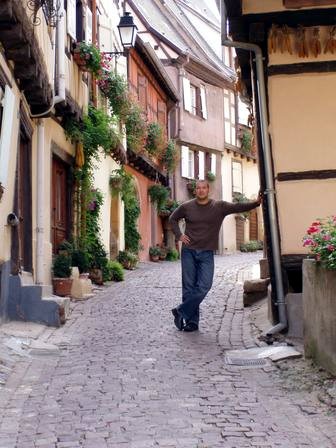Kristin has been volunteering her time the past few years with Habitat for Humanity's overseas arm, known as 'Global Village,' taking her to Tanzania and India to build homes for families that don't have a decent place to live. When some of the people whom she had met on past trips started to plan a short, spring-break trip for early in 2008, I decided to go with her - my first HfH trip! As the planning fleshed out, we discovered that we were going to go to El Salvador, and that there would be 18 people on our team, from such diverse places as Manhattan (both Kansas, and NYC!) Washington D.C., Los Angeles, Calgary, Pennsylvania, Chico CA, Ann Arbor MI, and Ontario Canada.
As the date of departure drew nearer, we found out that we would be part of a 'Blitz-Build' with several other teams with members from around the U.S, Canada, and Spain. The total number of international volunteers was around 100, with about the same number of Salvadorean volunteers from several universities throughout the country, as well as 10-20 military volunteers. In addition, the homeowners are required to put a certain number of hours in every week, as 'sweat equity' in their homes - though since this was Holy Week, many of them were busy observing religious responsibilities within their churches - (particularly on Good Friday, the homeowners seemed scarce.) We were excited about the prospect of so much manpower, and anticipated seeing a lot of work accomplished over the week of workdays.
We were based in the Santa Ana department of the country, in the northwest along the Guatemala border. This is a beautiful, very active volcanic region with very large volcanic mountains, crater lakes, and rich agriculture. Much of the shade-grown coffee farming in the country is centered in this region, and several of El Salvador's largest National Parks are also located in the region, such as Volcanoes National Park. We stayed in a hotel in Santa Ana, a city of nearly 200,000 people, which was about 20 miles away from the jobsite, and were ferried to and from the worksite on some of the colorful busses that you can see pictured in one of my earlier posts.
The project itself was very interesting: where most Habitat builds focus on one building within a mixed neighborhood of other homes, this project is an ambitious build - a planned development with housing for 54 individual families in either single-family or duplex homes, complete with a community center, a community day-care center (to allow the mothers to leave their children safely while they sought work,) and clean, potable water, electricity, and waste water treatment. This community was named "Charlotte" after the Charlotte, North Carolina Habitat affiliate whom has been really active in building housing in El Salvador, contributing large numbers of teams and contributions to make this a reality. The Charlotte community is to serve as a model for further developments of a similar nature throughout each of the departments, or states, within El Salvador.
Some of the information that we were given in our briefing on the first evening; the housing deficit in El Salvador is about 600,000 homes - this is in a country of just 7 million people, meaning that nearly 20% of the citizens are living in substandard housing that is hazardous to health and safety. 11% of El Salvador's economy is dependent upon remittances from family members who are living and working within the United States, sending money home when they can.
Being such a geologically active country has also shaped this need for housing. With frequent powerful earthquakes (2001 brought two earthquakes of devastating power -7.7 on the Richter scale within one month, killing over 1100 people, and damaging 20% of the nation's housing,) volcanic eruptions which interrupt agriculture and destroy crops, and susceptibility to Caribbean hurricanes, El Salvador has been a difficult place for people to find the stability needed to bring their country to prosperity.
The turbulent political history of the country, particularly the civil war between 1979 and 1991, means that although people may have land that they live on and even farm, it can be difficult and expensive for them to legalize their ownership of that land; this is one area that Habitat is also helping to provide legal fees and expertise. This is another reason for the format of the Charlotte community - ordinarily Habitat requires that the family being helped can show clear title to the land before a home is built - this precludes a lot of Salvadoreans. By providing both land and homes, the Charlotte community solves these two problems at once.
Above, I attached several photos of the Charlotte Community, including an overview map and some photos of the work underway. There are TONS more photos on our flickr.com account - if you see cinder blocks or a dirty face in a photo, there is a good chance that the picture was from the Charlotte community!
(My statistics are just reported as I remember them told to me. There is a pretty good chance that I am at least somewhat inaccurate. If you have some corrections - please send them to my comments link! I don't understand very much about the subtleties of El Salvadorean history and politics even now, but want to learn more. To read more about El Salvador, check out the Wikipedia entry - it has a bunch of references as well.)







No comments:
Post a Comment